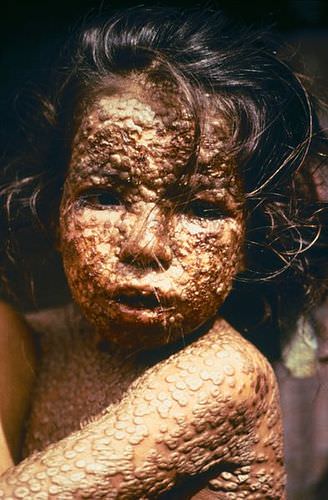1.2 科学是什么?
章节大纲
-
Ouch!
::哎哟!This young man is getting a flu vaccine . You probably know that getting a vaccine can hurt — but it's usually worth it. A vaccine contains dead or altered forms of germs that normally cause a disease, such as flu or measles. The germs in vaccines have been inactivated or weakened so they can no longer cause illness, but are still "noticed" by the immune system . They stimulate the immune system to produce chemicals that can kill the actual germs if they enter the body, thus preventing future disease. How was such an ingenious way to prevent disease discovered? The short answer is more than two centuries of science .
::这个年轻人正在获得流感疫苗。你可能知道获得疫苗会受伤,但通常值得这样做。疫苗含有通常导致疾病,如流感或麻疹的死菌或变异细菌。疫苗中的细菌已经不活跃或变弱,因此不再引起疾病,但免疫系统仍然“注意到 ” 。它们刺激免疫系统生产化学物质,这些化学物质一旦进入人体,就能够杀死实际的细菌,从而预防未来疾病。如何以这种巧妙的方式预防发现疾病呢?简短的答案是两个多世纪的科学。Science as Process
::科学过程You may think of science as a large and detailed body of knowledge, but science is also the process by which this knowledge is obtained . Science uses experimentation, evidence , and logic to continuously test ideas. Over time and through repeated e xperimentation and testing, scientific knowledge advances.
::你可以将科学视为一个庞大而详细的知识体系,但科学也是获得这种知识的过程。 科学利用实验、证据和逻辑来不断测试思想。 随着时间的推移,通过反复试验和测试,科学知识不断进步。We've been accumulating knowledge of vaccines for more than two centuries. The discovery of the first vaccine, as well as the process of vaccination , dates back to 1796. An English doctor named Edward Jenner observed that people who became infected with cowpox did not get sick from smallpox, a similar but much more severe disease (see the child with smallpox in the photo ). Jenner decided to transmit cowpox to a young boy to see if it would protect him from smallpox. He gave the boy cowpox by scratching liquid from cowpox sores into the boy's skin. Then, six weeks later, he scratched liquid from smallpox sores into the boy's skin. As Jenner predicted, the boy did not get sick from smallpox. Jenner had discovered the first vaccine, although additional testing was needed to show that it really was effective.
::我们积累了超过两个世纪的疫苗知识。发现第一种疫苗以及接种疫苗的过程可以追溯到1796年。一位名叫爱德华·詹纳的英国医生观察到,受天花感染的人并没有因为天花而生病,天花是一种类似但更严重的疾病(照片中还有天花的孩子)。詹纳决定把天花传给一个年轻男孩,看它是否能保护他免受天花的侵扰。他通过从天花溃疡中抓液体进入男孩的皮肤,给男孩牛瘟。然后,六周后,他从小天花溃疡中抓出液体进入男孩的皮肤。正如詹纳预测的那样,这名男孩并没有因为天花而生病。詹纳发现了第一种疫苗,尽管还需要额外的测试才能证明它确实有效。A young child in Bangladesh is covered with skin lesions from smallpox. Until it was eradicated, this highly contagious infection caused many deaths, and those that survived were often severely scarred for life.
::在孟加拉国,一个幼儿被天花的皮肤损伤所覆盖。 在消灭这一疾病之前,这种高度传染性感染造成了许多死亡,而幸存下来的儿童往往终身受到严重的创伤。Almost a century passed before the next vaccine was discovered, a vaccine for cholera in 1879. Around the same time, French chemist Louis Pasteur found evidence that many human diseases are caused by germs, which earned him the title of "father of germ theory ." Since Pasteur's time, vaccines have been discovered for scores of additional diseases caused by germs, and scientists are currently researching vaccines for many others.
::1879年,法国化学家路易斯·巴斯德(Louis Pasteur)发现许多人类疾病是由细菌引起的,这让他获得了“细菌理论之父”的称号。 自巴斯德(Pasteur)时代以来,已经发现了数十种细菌引起的其他疾病的疫苗,科学家目前正在为许多其他疾病研究疫苗。Benefits of Science
::科学的惠益Medical advances such as the discovery of vaccines are one of the most important benefits of science, but science and scientific knowledge are also crucial for most other human endeavors. Science is needed to design safe cars, predict storms, control , develop new technologies of many kinds, help couples have children, and put a man on the moon. Clearly, the diversity of applications of scientific knowledge is vast!
::疫苗的发现等医学进步是科学最重要的好处之一,但科学和科学知识对于人类的多数其他努力也至关重要。 需要科学来设计安全汽车、预测风暴、控制、开发多种新技术、帮助夫妇生育子女、让人类登月。 显然,科学知识应用的多样性是巨大的!Summary
::摘要-
Science is a large and detailed body of knowledge. It is also the process by which this knowledge is obtained.
::科学是一个庞大而详细的知识体系,也是获得这种知识的过程。
::科学是一个庞大而详细的知识体系,也是获得这种知识的过程。 -
Science uses experimentation, evidence, and logic to continuously test ideas. Over time and through repeated experimentation and testing, scientific knowledge advances.
::科学利用实验、证据和逻辑来不断测试思想。 随着时间的推移,通过反复试验和测试,科学知识不断进步。
::科学利用实验、证据和逻辑来不断测试思想。 随着时间的推移,通过反复试验和测试,科学知识不断进步。 -
Medical advances such as the development of vaccines are one of the most important benefits of science, but science and scientific knowledge are also crucial for most other human endeavors.
::研制疫苗等医学进步是科学最重要的好处之一,但科学和科学知识对于人类其他多数努力也至关重要。
Review
::回顾1. Explain why science is considered both a process and a body of knowledge.
::1. 解释为什么科学既被视为一个过程,又被视为知识的主体。2. State three specific examples of human endeavors that are based on scientific knowledge.
::2. 列举三个基于科学知识的人类努力的具体例子。3. Jenner used a young boy as a research subject in his smallpox vaccine research. Today, scientists must follow strict guidelines when using human subjects in their research. What unique concerns do you think might arise when human beings are used as research subjects?
::3. 詹纳在其天花疫苗研究中将一个年轻男孩作为研究对象,如今,科学家在研究时必须严格遵守使用人类研究对象的准则。4. What gave Jenner the idea to develop a vaccine for smallpox?
::4. 是什么给了詹纳开发天花疫苗的想法?5. Why do you think almost a century passed between the development of the first vaccine (for smallpox) and the development of the next vaccine (for cholera)?
::5. 为什么你认为第一种疫苗(天花疫苗)的研制与下一个疫苗(霍乱疫苗)的研制之间过了将近一个世纪?6. How does science influence your daily life?
::6. 科学如何影响你的日常生活?Explore More
::探索更多Watch this eye-opening TED talk to learn why truly innovative science demands a leap into the unknown. The inspiring speaker explains how improv theater helped him find joy instead of fear in the unknown and how to use creativity in the scientific process.
::看着TED这个开眼的演讲来了解为什么真正的创新科学需要跳跃到未知的地步。这位鼓舞人心的演讲者解释了即兴剧场如何帮助他找到快乐而不是恐惧,以及如何在科学过程中利用创造力。Check out this video to learn more about the s mallpox vaccine:
::以了解更多有关天花疫苗的影片: -

